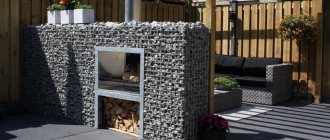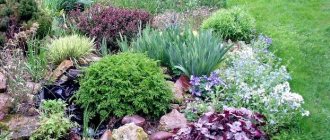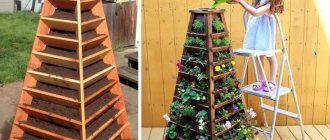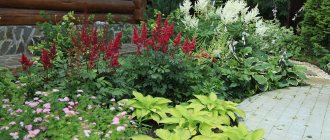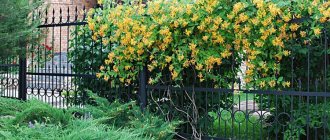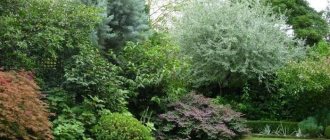Gladiolus is a majestic flower and the recognized king of the garden. He earned the love of flower growers thanks to his presentable appearance. The incomparable structure gives rise to a logical question of how to use gladioli in landscape design. A description of the varieties and nuances of cultivation will help with arranging a flower arrangement on your own site.
The character of a royal person
When designing landscape design, a large amount of vegetation is used. Some views serve as a frame, others act as an accent. Gladioli in the flowerbed always play a dominant role. But for the composition to look harmonious, the royal flower requires a retinue, in which it is recommended to use less expressive specimens.
The entire diversity of gladioli is represented by more than 200 plant species, which in turn number over 1000 varieties. Despite the wide choice, when designing landscape design, many experts are afraid to include a unique flower in the overall composition. The reason lies in the unusual structure. If you use single specimens in landscape design, gladiolus will lose its majesty. Planting a large group of royal flowers can cause some chaos in the flowerbed, which will lose its expressiveness.
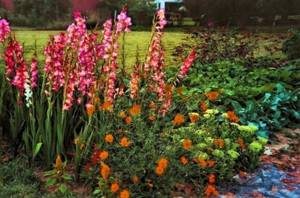
Attention! Proper observance of proportions between gladioli and other surrounding vegetation will help to obtain a harmonious composition in landscape design.
The opinion that it is best to use gladiolus as a cut flower to create chic bouquets is somewhat erroneous. There are many options for combining a flower when it will look beneficial in the overall landscape design picture. But first, it’s worth understanding the variety of species. Numerous photos will give an idea of the grace of the royal flower.
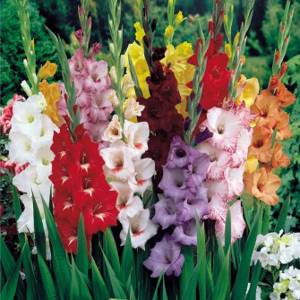
We are looking for suitable “companions” in the flowerbed
Gladioli are a rather complex plant in terms of creating flower arrangements. A large number of plants gives the garden a neglected look, and single flowers look dull. However, by skillfully combining gladioli with other flowers, you can create amazingly beautiful compositions. Gladioli are surrounded by those flowers that are ready to provide beauty to the flowerbed at any time. These flowers include tulips, daffodils, and peonies.
You should not plant gladioli and dahlias next to each other, they will shade each other. Tall dahlias and low-growing plants are successfully combined. To make a flower bed of gladioli look organic, you can plant several bulbs at the same time. Flowers in contrasting shades look good.
For a flowerbed, 3 different varieties will be enough. You should not combine small-flowered and large-flowered plants.
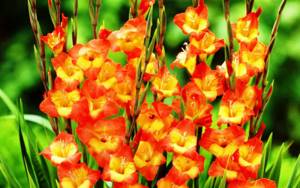
Species diversity of gladioli
Gladiolus received its second name “sword knife” due to its unusual shape, which vaguely resembles a sharp sword. The flowers belong to the iris family and are a perennial corm plant. For better orientation among hybrid species, classification can be carried out according to several criteria.
According to flowering times, they are distinguished:
- early;
- average;
- late.
Depending on the variety, the period between planting and the formation of buds lasts from 70 to 95 days. The tallest gladioli reach a height of 1.7 m, which is very convenient if you need to create a bright accent in your landscape design.
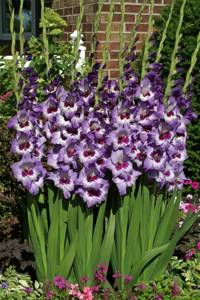
There is a gradation into 5 groups depending on the size of the flower:
- Small ones do not exceed 6-7 cm in diameter.
- Small-flowered ones grow up to 10 cm.
- The maximum diameter of medium-flowered varieties is 12 cm.
- Large-flowered ones reach 15 cm.
- The leaders in size are giant gladioli, each flower of which, with proper care, can exceed 17 cm in diameter.
In addition, the shape of the petals also differs. Some varieties are presented with simple flowers with smooth edges, while others amaze with their beauty due to their corrugated edges. The color can be monochromatic or combined. In total, there are 11 main groups on this basis.
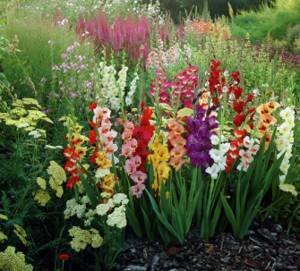
All indicators are taken into account in the nomenclature used by experienced gardeners when choosing bulbs for planting. It also contains information about the number of flowers in one inflorescence, the degree of their corrugation, and what height a gladiolus can reach.
The arrangement of flowers on the stem also differs. It happens:
- one-sided and two-sided;
- spiral;
- spicate.
Such a variety of shapes, sizes and shades provides an innumerable number of options for landscape design using gladioli.
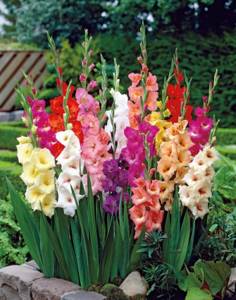
We analyze the disadvantages of gladioli
Decorators don’t want to mess with gladioli because:
- due to its high growth and bare lower part, gladiolus needs short companions;
- it is difficult to determine how many gladioli will look most attractive: if you plant several specimens, then the majesty of the flower will be leveled out against the background of other plants, and if you plant a lot of gladioli, the planting will look like a regular plantation;
- careful selection of color combinations is necessary, because the majesty of the flower is lost in the variegation;
- tall gladioli require garters, and supporting structures are rarely attractive;
- In autumn, gladioli are usually dug up, and this is difficult to do without damaging the roots of neighboring plants;
- this plant needs a background that will emphasize and enhance its unusual, solemn beauty;
- gladiolus is decorative only for a few days a season, and then it loses its attractiveness, and ideally it should be cut off without allowing it to bloom completely so that the bulb has time to gain strength for successful flowering next year;
- Gladiolus varieties differ not only in the color of the flowers, but also in their size, as well as the height of the bush and the timing of flowering.
How to choose the right onion - buy the right one
For anyone who knows these features of gladiolus, it will not be difficult to make advantages out of them.
- Planting flowers for seedlings in April
Nuances of use in landscape design
Skewer is considered a capricious plant regarding care requirements. But even a single experience in arranging a composition with gladioli in landscape design will be an impetus to use exquisite flowers again and again. A flowerbed with a skewer is called a gladularium. Plant catalogs with detailed descriptions and illustrated photos will help you decide on the gladiolus variety suitable for a particular site.

Creating a harmonious composition is not an easy task; the main thing here is to ensure that the accent element is commensurate with the accompanying frame. The number of copies and color palette matter. When striving for a rich picture, do not forget about moderation in order to avoid clumsiness.
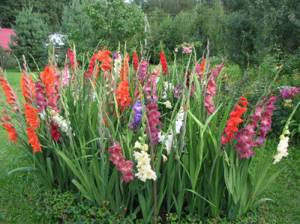
The beauty of the sword itself is self-sufficient. But two factors make you think about faithful companions. The first is the short flowering time. To ensure that the landscape design area with gladioli does not gape empty, you should take care of bright colors for the rest of the period. The second reason is the tall stem of the fennel, which is better covered with low-growing crops. Planting ornamental crops with lush foliage and different flowering periods will help cope with the task. In landscape design where gladularia is present, you can use the following combination:
- The end of spring will delight you with colorful hyacinths and the traditional combination of daffodils and tulips.
- The first half of summer will fill the area with the aroma of low-growing peonies and graceful irises, cute daisies.
- Then it’s the turn of the swordsman.
- The beginning of autumn is the time of hydrangeas, asters and chrysanthemums.
Advice! It is optimal to use different varieties of gladioli in landscape design relative to the flowering period, then the flowerbed will glow with bright colors for at least one month.
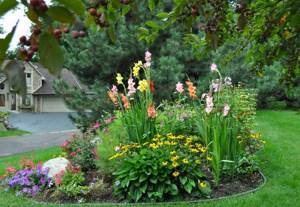
If you decide to use gladioli in landscape design, you should listen to other recommendations from experts:
- It is better to avoid the proximity of fennel to dahlias. The reason is simple - their flowering time practically coincides, two bright elements of landscape design will interrupt each other, making it difficult to create a clear accent in the composition.
- The optimal number of gladioli in one group planting is from 10 to 15 specimens. This will allow you to create an expressive spot of color in your landscape design. When choosing planting material, in addition to the flowering period, be sure to take into account the combination of shades.
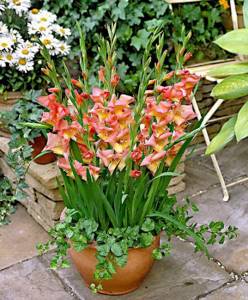
- It is better to use varieties of gladioli with a combined color separately in landscape design so that they fully reveal their beauty and do not get lost in the general background.
- In the background of a flower bed with gladioli, it is recommended to use plants that are uniform in structure and color. Evergreen crops or conifers are optimal. Tall shrubs and ornamental trees look quite organic in landscape design with fennel.
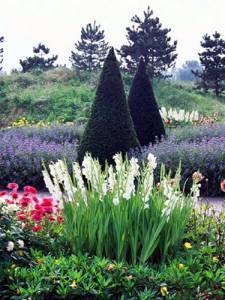
- Gladioli corms are dug up for the winter, so when choosing a close frame for flowers, it is advisable to use annual crops in landscape design. The presence of a branched root system of perennial flowers will complicate the process of preparing skewer bulbs for the winter.
- Low-growing varieties of gladioli, which are not for nothing called border varieties, can also find a worthy place in landscape design. Low, beautiful flowers are best used when decorating paths and lawns. Combining different shades will allow you to create exquisite paintings in landscape design.
- It is not recommended to use the juxtaposition of small-flowered and large-flowered varieties of gladioli in landscape design. Large flowers involuntarily attract the eye; against their background, smaller representatives lose their attractiveness.
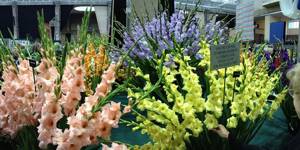
Depending on the height of the skewer, in most cases during the flowering period they need to be equipped with supports that will support heavy inflorescences. In addition to the proposed combinations in the composition with gladioli, low-growing daylilies and hosta are suitable for landscape design. You can use sage, rue and oregano, phlox, lavateria and zinnias. When it is decided to use a sword in a ceremonial mixborder, the ideal complement will be juniper, conifers and natural stones.
Photos of gladioli in landscape design confirm the sophistication of royal beauty flowers.

Ideas for flower beds with beautiful gladioli
I used to be afraid to plant gladioli in my garden. It seemed to me that I would have to tinker with them a lot, that they were very finicky, and stuff like that. But today, with six years of experience in growing these delightful flowers, the only problem for me is planning the composition.
At first, I planted gladioli in small groups in a flowerbed with perennials. But at the same time, it is necessary to retreat a decent distance from their roots so as not to damage them when preparing the soil for the bulbs. The result was bald spots in the flower garden.
Today I prefer to arrange gladioli with annuals, or with perennial flowers that need to be dug up for the winter. It turns out that at the same time I plant all the plants from the plan, and also almost simultaneously remove them in the fall.
Speaking of annuals only, I like the idea of a bed of gladioli with petunias, snapdragons and tobacco. Not only do they all bloom continuously from June to September (except for the gladioli themselves), but they also smell incredible.
Garden callas cannot withstand our Siberian winters, so they also have to be stored in the basement. They are relatively low, making them perfect for the foreground of a flower bed. In this example, I combined them with datura, asters and annual dahlias.
The first two options are in my favorite white and pink color combination. But I also really love red gladioli. During their flowering period, the garden is transformed, becoming solemn and a little strict.
Marigolds and border perennial dahlias bloom very luxuriantly until the coldest weather. Coleus somewhat mutes the bright red and yellow color combination. And it is convenient to grow it from cuttings. I only bought a mixture of seeds once and chose the most interesting colors.
If you like projects like this, like and subscribe to the channel.
There is a lot of interesting things ahead.
Good luck to all! Source
Description of varieties
There are eleven main shades of swords. The varieties listed below are optimally suited for cultivation by amateur gardeners. They are characterized by good growth, reproduce easily and are quite unpretentious in care. The proposed plants of different colors will facilitate the composition of landscape design:
- White. "Dmitry Solunsky" grows up to 1.8 m. The inflorescence is spike-shaped, the petals are corrugated. Up to 12 pieces bloom at the same time. “Moscow White Stone” is slightly lower, within 1.3-1.6 m. The petals are corrugated, up to 9 flowers bloom at a time in July, with a total of 21 buds on the stem.
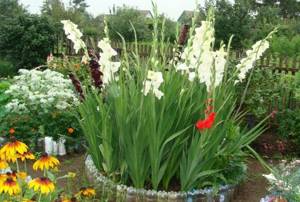
- Yellow. A drop of sun in landscape design will never be superfluous. At the end of June, the gladiolus “Krasava” will illuminate the area. Of the 24 flowers, 10 open immediately, the petals are corrugated. The medium-sized “Golden Bells” will delight you with 12 opened buds.
Attention! The yellow tint of gladioli indicates increased resistance to various diseases. Beginning flower growers should take this into account when creating a composition with swords in their landscape design. The beneficial quality is inherent in flowers at the genetic level.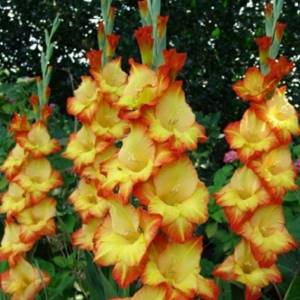
- Orange. The height of the Peter Pierce variety varies between 0.8-1.5 m. It blooms from July to September. Does not tolerate low temperatures well and needs support. “Amber Baltic” has a fawn color, with red inclusions inside. Easy propagation and the absence of special requirements for agricultural technology are the key advantages of this variety of gladiolus.
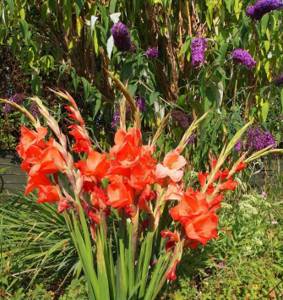
- Reds. To create a bright accent in the landscape design of a flower bed, it is recommended to use the tall “Black Surprise”, which reaches 2 m. It blooms in July, red flowers can have a pink or purple tint. The “Give Me a Smile” variety will be an effective decoration for landscape design. The main advantage of gladiolus is its large flowers, which reach a diameter of 14 cm. A pleasant bonus is the powerful growth and good health of the flower.
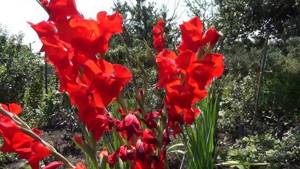
- Green. The height of “Radiant Green” is 1.5 m. Gladiolus will bloom 82 days after planting, even despite unfavorable natural factors.
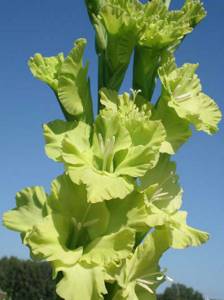
- Violet-lilac. The “Neon Lightning” variety will give your landscape design a lilac-blue hue. The low-growing gladiolus “Violetta” with blue-violet flowers, the height of which does not exceed 60 cm, will decorate the border.
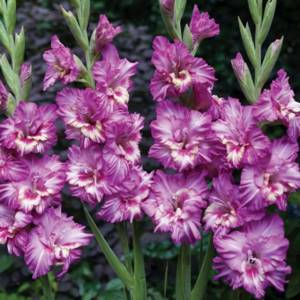
- Brown. The composition will look extremely impressive in landscape design if you use the “Chocolat” variety. The diameter of one flower is about 12 cm, the height of the stem is 1.2 m. This variety needs a garter.

Beautiful gladioli in the landscape in the photo below:
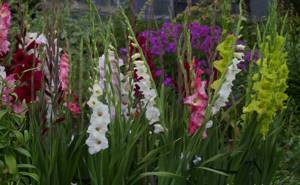
Features of cultivation
Gladiolus is classified as a capricious crop that is used in landscape design. The proposed growing recommendations will help you avoid annoying mistakes.
Selecting a location
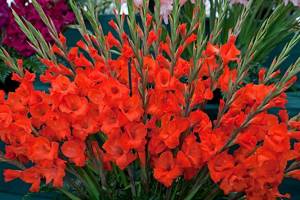
The first step towards an exquisite landscape design composition is to find a suitable place for the gladiolus. The choice is made according to several criteria:
- Illumination. Speechweed prefers sunny areas; shading will cause the inflorescences to shred and delay the time for their full formation.
- The soil. Gladioli should be planted on fertile soil. Chernozem, light loam or sandy loam composition are ideal for these purposes. Acidity also matters; optimal values range from 6 to 7 pH.
- Drainage. Skewer does not tolerate excessive moisture. Therefore, in landscape design it is recommended to find a flat topography; a slope of no more than 5° to the south will help eliminate excess moisture. It is also worth taking care of high-quality drainage, especially if the flowerbed is located in a lowland.
- Air currents. The wind has a detrimental effect on gladioli. If the landscape design allocates a place on a slope, or the site is located in northern latitudes, it is worth taking care of the construction of protective scenes. A solid fence can serve as a reliable barrier.
No matter how ideal the place in landscape design is, it is not recommended to use it in the second year. Below are the next photos of gladioli in landscape design:
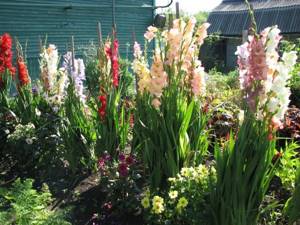
Useful predecessors
The search for a suitable space for planting gladioli should take into account last year's predecessors. The best development of flowers is observed if this place of landscape design was inhabited:
- dahlias;
- peas or beans;
- garlic or onion;
- zinnias or marigolds.
Comment! Avoid areas where potatoes, carrots and beets grew. Growing skewer in place of cabbage will lead to damage by wireworms and thrips. They do not like flowers and predecessors in the form of radishes, daikon and asters.
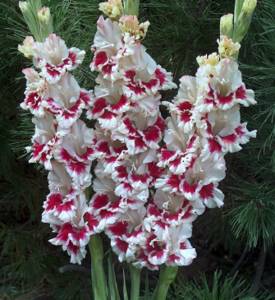
Care instructions
The requirements for agricultural technology do not contain impossible conditions. In order for your landscape design to be fully filled with the beauty of gladioli, you should not skip the usual care procedures:
- At the beginning of growth, fertilizing with organic fertilizers is organized.
- At the stage of development of leaves and buds, gladioli will be grateful for the application of mineral fertilizers.
- A beautiful picture of the landscape design will be preserved during spraying.
- Naturally, watering after sunset is vital.
- Mulching will help retain moisture.
- Access to oxygen to the root system will ensure loosening of the soil, and do not forget to get rid of weeds. They not only interfere with the development of gladioli, but also spoil the composition of the landscape design as a whole.
It is better for novice flower growers to choose unpretentious varieties of sword to decorate their landscape design. Experienced hobbyists will find it interesting to use new specimens.
The presence of gladiolus in the landscape design will absolutely provide the site with sophistication. Despite some difficulty in care, if the requirements of agricultural technology are met, the royal flower will delight the owner with a spectacular composition that cannot be created when using other ornamental crops.
Recommended Posts
DIY dry stream at the dacha + photo
Pond at the dacha + photo
Front garden in front of the house
DIY flowerbed from scrap materials
Landscape design ideas for school grounds
Fast growing climbing plants for a fence
